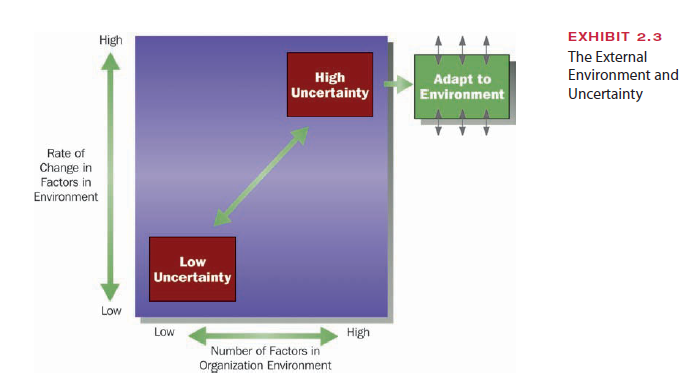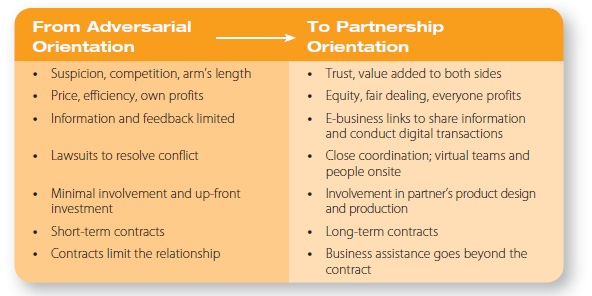Why do organizations care so much about factors in the external environment? The reason is that the environment creates uncertainty for organization managers, and they must respond by designing the organization to adapt to the environment.
1. ENVIRONMENTAL UNCERTAINTY
To be effective, organizations must manage environmental uncertainty. Uncertainty means that managers do not have sufficient information about environmental factors to understand and predict environmental needs and changes.28 As indicated in Exhibit 2.3, environmental characteristics that influence uncertainty are the number of factors that affect the organization and the extent to which those factors change. A large multinational such as Nortel Networks has thousands of factors in the external environment creating un- certainty for managers. When external factors change rapidly, the organization experiences high uncertainty. Examples are telecommunications and aerospace firms, computer and electronics companies, and e-commerce organizations that sell products and services over the Internet. Companies have to make an effort to adapt to the rapid changes in the envi- ronment. When an organization deals with only a few external factors and these factors are relatively stable, such as for soft-drink bottlers or food processors, managers experience low uncertainty and can devote less attention to external issues.

2. ADAPTING TO THE ENVIRONMENT
If an organization faces increased uncertainty with respect to competition, customers, suppliers, or government reg- ulations, managers can use several strategies to adapt to these changes, including boundary-spanning roles, interorganizational partnerships, and mergers or joint ventures.
People in departments such as marketing and purchas- ing span the boundary to work with customers and suppli- ers, both face-to-face and through market research. Some organizations are staying in touch with customers through the Internet, such as by monitoring gripe sites, communi- cating with customers on company websites, and contract- ing with market-research firms that use the web to moni- tor rapidly changing marketplace trends.29 Another approach to boundary spanning is the use of business intel- ligence, which results from using sophisticated software to search through large amounts of internal and external data to spot patterns, trends, and relationships that might be significant. For example, Verizon uses business intelli- gence software to actively monitor customer interactions and fix problems almost immediately.30
Boundary spanning is an increasingly important task in organizations because environmental shifts can happen so quickly in today’s world. To make good de- cisions, managers need good information about their competitors, customers, and other elements of the en- vironment. Thus, the most successful companies in- volve everyone in boundary-spanning activities. People at the grassroots often can see and interpret significant changes sooner than managers who are more removed from the day-to-day work.31 But top executives, too, have to stay in tune with the environment. Tom Stemberg, CEO of Staples, visits a competi- tor’s store once a week and shares what he learns with others on the management team.32 Perceiving environmental shifts that could impact the organization isn’t always easy. Managers must learn to not only interpret the data right in front of them but also to see weak signals on the periphery and answer the question, “What don’t we know that might matter?”
Managers are shifting from an adversarial orientation to a partnership orientation, as summarized in Exhibit 2.4. The new paradigm is based on trust and the ability of partners to work out equitable solutions to conflicts so everyone profits from the relationship. Managers work to reduce costs and add value to both sides rather than try to get all the benefits for their own company. The new model also is characterized by a high level of information sharing, including e-business link- ages for automatic ordering, payments, and other transactions.

In addition, person-to-person interaction pro- vides corrective feedback and solves problems. People from other companies may be onsite or participate in virtual teams to enable close coordi- nation. Partners frequently are involved in one another’s product design and production, and they are committed for the long term. It is not unusual for business partners to help one another, even outside of what is specified in the contract.34
A step beyond strategic partnerships is for companies to become involved in mergers or joint ventures to reduce environmental uncertainty. A merger occurs when two or more organizations combine to become one. For example, Wells Fargo merged with Norwest Corp. to form the nation’s fourth largest banking corporation. A joint venture involves a strategic alliance or program by two or more organizations. A joint venture typically occurs when a project is too com- plex, expensive, or uncertain for one firm to han- dle alone. Oprah Winfrey’s Harpo Inc. formed a joint venture with Hearst Magazines to launch O, The Oprah Magazine.
Source: Daft Richard L., Marcic Dorothy (2009), Understanding Management, South-Western College Pub; 8th edition.

I like this site very much, Its a rattling nice place to read and incur info .